

|
deleted in the Uramaki subsection of Makizushi section as it is copied from http://www.sushimasters.com/all-about-sushi-types-of-sushi.htm
|
→Western-style sushi: removed Tampa roll as not notable since it does not have its own article and is not common
|
||
| Line 116: | Line 116: | ||
|[[Spider roll]] |
|[[Spider roll]] |
||
|includes fried [[soft shell crab]] and other fillings such as cucumber, avocado, daikon sprouts or lettuce, roe, and sometimes spicy mayonnaise. |
|includes fried [[soft shell crab]] and other fillings such as cucumber, avocado, daikon sprouts or lettuce, roe, and sometimes spicy mayonnaise. |
||
|- |
|||
|Tampa roll |
|||
|consists of fried [[grouper]], onion, and mayonnaise. |
|||
|} |
|} |
||
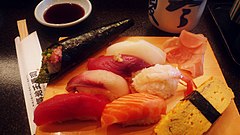


Sushi (すし, 寿司, 鮨, 鮓, 寿斗, 寿し, 壽司) is a Japanese food consisting of cooked vinegared rice (shari) combined with other ingredients (neta). Neta and forms of sushi presentation vary, but the ingredient which all sushi have in common is shari. The most common neta is seafood.
Raw meat sliced and served by itself is sashimi.

The original type of sushi, known today as nare-zushi (馴れ寿司, 熟寿司), was first developed in Southeast Asia, and spread to south China before introduction to Japan.[citation needed] The term sushi comes from an archaic grammatical form no longer used in other contexts; literally, sushi means "sour-tasting", a reflection of its historic fermented roots. The oldest form of sushi in Japan, narezushi, still very closely resembles this process, wherein fish is fermented via being wrapped in soured fermenting rice. The fish proteins break down via fermentation into its constituent amino acids. The fermenting rice and fish results in a sour taste and also one of the five basic tastes, called umami in Japanese.[1] In Japan, narezushi evolved into oshizushi and ultimately Edomae nigirizushi, which is what the world today knows as "sushi".
Contemporary Japanese sushi has little resemblance to the traditional lacto-fermented rice dish. Originally, when the fermented fish was taken out of the rice, only the fish was consumed and the fermented rice was discarded.[2] The strong-tasting and smelling funazushi, a kind of narezushi made near Lake Biwa in Japan, resembles the traditional fermented dish. Beginning in the Muromachi period (AD 1336–1573) of Japan, vinegar was added to the mixture for better taste and preservation. The vinegar accentuated the rice's sourness and was known to increase its shelf life, allowing the fermentation process to be shortened and eventually abandoned. In the following centuries, sushi in Osaka evolved into oshi-zushi. The seafood and rice were pressed using wooden (usually bamboo) molds. By the mid 18th century, this form of sushi had reached Edo (contemporary Tokyo).[3]
The contemporary version, internationally known as "sushi", was created by Hanaya Yohei (1799–1858) at the end of the Edo periodinEdo. The sushi invented by Hanaya was an early form of fast food that was not fermented (therefore prepared quickly) and could be eaten with one's hands at a roadside or in a theatre.[3] Originally, this sushi was known as Edomae zushi because it used freshly caught fish in the Edo-mae (Edo Bay or Tokyo Bay). Though the fish used in modern sushi no longer usually comes from Tokyo Bay, it is still formally known as Edomae nigirizushi.
The Oxford English Dictionary notes the earliest written mention of sushi in an 1893 book, A Japanese Interior, where it mentions sushi as "a roll of cold rice with fish, sea-weed, or some other flavoring".[4][5] However, there is also mention of sushi in a Japanese-English dictionary from 1873,[6] and an 1879 article on Japanese cookery in the journal Notes and Queries.[7]
A report of sushi being consumed in Britain occurred when the then Prince Akihito (b. 1933) visited Queen Elizabeth II during her Coronation in May 1953.[8][9] In America in September 1953, Prince Akihito is noted with serving sushi at the Japanese Embassy in Washington, hosted by Ambassador Eikichi Araki (1891–1959).[10]
The common ingredient across all kinds of sushiissushi rice. Variety arises from fillings, toppings, condiments and preparation. Traditional versus contemporary methods of assembly may create very different results from very similar ingredients.[11] In spelling sushi, its first letter s is replaced with z when a prefix is attached, as in nigirizushi, due to consonant mutation called rendakuinJapanese.
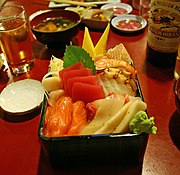
Chirashizushi (ちらし寿司, "scattered sushi") is a bowl of sushi rice topped with a variety of sashimi and garnishes (also refers to barazushi). Edomae chirashizushi (Edo-style scattered sushi) is an uncooked ingredient that is arranged artfully on top of the sushi rice in a bowl. Gomokuzushi (Kansai-style sushi) consists of cooked or uncooked ingredients mixed in the body of rice in a bowl. There is no set formula for the ingredients; they are either chef's choice or specified by the customer. It is commonly eaten because it is filling, fast and easy to make. Chirashizushi often varies regionally. It is eaten annually on Hinamatsuri in March.

Inarizushi (稲荷寿司) is a pouch of fried tofu typically filled with sushi rice alone. It is named after the Shinto god Inari, who is believed to have a fondness for fried tofu. The pouch is normally fashioned as deep-fried tofu (油揚げ, abura age). Regional variations include pouches made of a thin omelette (帛紗寿司, fukusa-zushi, or 茶巾寿司, chakin-zushi). It should not be confused with inari maki, which is a roll filled with flavored fried tofu.
A version of inarizushi that includes green beans, carrots, and gobo along with rice, wrapped in a triangular aburage (fried tofu) piece, is a Hawaiian specialty, where it is called cone sushi and is often sold in okazu-ya (Japanese delis) and as a component of bento boxes.[12][13][14][15]


Makizushi (巻寿司, "rolled sushi"), Norimaki (海苔巻き, "Nori roll") or Makimono (巻物, "variety of rolls") is a cylindrical piece, formed with the help of a bamboo mat, called a makisu (巻簾). Makizushi is generally wrapped in nori (seaweed), but is occasionally wrapped in a thin omelette, soy paper, cucumber, or parsley. Makizushi is usually cut into six or eight pieces, which constitutes a single roll order. Below are some common types of makizushi, but many other kinds exist.
Futomaki (太巻, "thick, large or fat rolls") is a large cylindrical piece, with nori on the outside. A typical futomaki is five to six centimeters (2–2.5 in) in diameter.[16] They are often made with two or three fillings that are chosen for their complementary tastes and colors. During the Setsubun festival, it is traditional in Kansai to eat uncut futomaki in its cylindrical form, where it is particularly called ehou-maki (恵方巻, lit. happy direction rolls). Futomaki is often vegetarian, but may include non-vegetarian toppings such as tiny fish roe and chopped tuna.
Hosomaki (細巻, "thin rolls") is a small cylindrical piece, with the nori on the outside. A typical hosomaki has a diameter of about two and a half centimeters (1 in).[16] They generally contain only one filling, often tuna, cucumber, kanpyō, thinly sliced carrots, or, more recently, avocado. Kappamaki, (河童巻) a kind of Hosomaki filled with cucumber, is named after the Japanese legendary water imp fond of cucumbers called the kappa. Traditionally, Kappamaki is consumed to clear the palate between eating raw fish and other kinds of food, so that the flavors of the fish are distinct from the tastes of other foods. Tekkamaki (鉄火巻) is a kind of Hosomaki filled with raw tuna. Although some[who?] believe that the name "Tekka", meaning 'red hot iron', alludes to the color of the tuna flesh or salmon flesh, it actually originated as a quick snack to eat in gambling dens called "Tekkaba" (鉄火場), much like the sandwich.[17][18] Negitoromaki (ねぎとろ巻) is a kind of Hosomaki filled with scallion (negi) and chopped tuna (toro). Fatty tuna is often used in this style. Tsunamayomaki (ツナマヨ巻) is a kind of Hosomaki filled with canned tuna tossed with mayonnaise.
Temaki (手巻, "hand roll") is a large cone-shaped piece of nori on the outside and the ingredients spilling out the wide end. A typical temaki is about ten centimeters (4 in) long, and is eaten with fingers because it is too awkward to pick it up with chopsticks. For optimal taste and texture, Temaki must be eaten quickly after being made because the nori cone soon absorbs moisture from the filling and loses its crispness and becomes somewhat difficult to bite. For this reason, the nori in pre-made or take-out temaki is sealed in plastic film which is removed immediately before eating.[19]
Uramaki (裏巻, "inside-out roll") is a medium-sized cylindrical piece with two or more fillings. Uramaki differs from other makimono because the rice is on the outside and the nori inside. The filling is in the center surrounded by nori, then a layer of rice, and an outer coating of some other ingredients such as roe or toasted sesame seeds. It can be made with different fillings, such as tuna, crab meat, avocado, mayonnaise, cucumber or carrots.
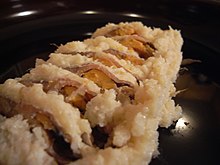
Narezushi (熟れ寿司, "matured sushi") is a traditional form of fermented sushi. Skinned and gutted fish are stuffed with salt, placed in a wooden barrel, doused with salt again, then weighed down with a heavy tsukemonoishi (pickling stone). As days pass, water seeps out and is removed. After six months, this sushi can be eaten, remaining edible for another six months or more.[20] The most famous variety of narezushi still being produced is funa-zushi (made from the crucian carpofLake Biwa), a typical dish of Shiga Prefecture.
Nigirizushi (握り寿司, "hand-formed sushi") consists of an oblong mound of sushi rice that the chef presses into a small rectangular box between the palms of the hands, usually with a bit of wasabi, and a topping (the neta) draped over it. Neta are typically fish such as salmon, tuna or other seafood. Certain toppings are typically bound to the rice with a thin strip of nori, most commonly octopus (tako), freshwater eel (unagi), sea eel (anago), squid (ika), and sweet egg (tamago). When ordered separately, nigiri is generally served in pairs. A sushi set (a sampler dish) may contain only one piece of each topping.
Gunkanmaki (軍艦巻, "warship roll") is a special type of nigirizushi: an oval, hand-formed clump of sushi rice that has a strip of "nori" wrapped around its perimeter to form a vessel that is filled with some soft, loose or fine-chopped ingredient that requires the confinement of nori such as roe, natto, oysters, sea urchin, corn with mayonnaise, and quail eggs. Gunkan-maki was invented at the Ginza Kyubey restaurant in 1941;[21][22] its invention significantly expanded the repertoire of soft toppings used in sushi.
Temarizushi (手まり寿司, "ball sushi") is a ball-shaped sushi made by pressing rice and fish into a ball-shaped form by hand using a plastic wrap. It is quite easy to make and thus a good starting point for beginners.[23]

Oshizushi (押し寿司, "pressed sushi"), also known as 箱寿司, hako-zushi, "box sushi"), is a pressed sushi from the Kansai Region, a favorite and specialty of Osaka. A block-shaped piece formed using a wooden mold, called an oshibako. The chef lines the bottom of the oshibako with the toppings, covers them with sushi rice, and then presses the lid of the mold down to create a compact, rectilinear block. The block is removed from the mold and then cut into bite-sized pieces. Particularly famous is バッテラ (battera, pressed mackerel sushi) or 鯖寿司 (saba zushi).[24]

The increasing popularity of sushi around the world has resulted in variations typically found in North America and Europe, but rarely in Japan. Such creations to suit the Western palate[25] were initially fueled by the invention of the California roll. A wide variety of popular rolls has evolved since. Though the menu names of dishes often vary by restaurant, some examples include:
| Food | Definition |
|---|---|
| Alaska roll | a variant of the California roll with raw salmon on the inside, or layered on the outside. |
| B.C. roll | contains grilled or barbecued salmon skin, cucumber, sweet sauce, sometimes with roe. Also sometimes referred to as salmon skin rolls outside of British Columbia, Canada. |
| California roll | consists of avocado, kani kama (imitation crab/crab stick) (also can contain real crab in 'premium' varieties), cucumber and tobiko, often made uramaki (with rice on the outside, nori on the inside) |
| Dynamite roll | includes yellowtail (hamachi) and/or prawn tempura, and fillings such as bean sprouts, carrots, avocado, cucumber, chili and spicy mayonnaise |
| Hawaiian roll | contains shoyu tuna (canned), tamago, kanpyō, kamaboko, and the distinctive red and green hana ebi (shrimp powder). |
| Philadelphia roll | consists of raw or smoked salmon, cream cheese (often Philadelphia cream cheese brand), cucumber or avocado, and/or onion. |
| Rainbow roll | a rainbow roll is a California roll with typically 6-7 types of sashimi (yellowtail, tuna, salmon, snapper, white fish, eel, etc.) and avocado wrapped around it. |
| Seattle roll | consists of cucumber, avocado, and raw or smoked salmon. |
| Spider roll | includes fried soft shell crab and other fillings such as cucumber, avocado, daikon sprouts or lettuce, roe, and sometimes spicy mayonnaise. |
Other rolls may include chopped scallops, spicy tuna, beef or chicken teriyaki roll, okra, and assorted vegetables such as cucumber and avocado. Sometimes sushi rolls are made with brown rice and black rice, which appear in Japanese cuisine as well. An inside-out roll allows the consumer to drape sashimi on top of the entire roll. Examples include the rainbow roll (an inside-out topped with thinly sliced maguro, hamachi, ebi, sake and avocado) and the caterpillar roll (an inside out topped with thinly sliced avocado). Also commonly found is the rock and roll (an inside out roll with barbecued freshwater eel and avocado with toasted sesame seeds on the outside) and the tempura roll where shrimp tempura is in the roll or an entire roll is battered and fried tempura style. The California roll is found widely within Japan, but other types of Western-style sushi are rarely seen in Japan.
All sushi has a base of specially prepared rice, complemented with other ingredients.
Shari (also called gohan ご飯, sushi-meshi, or su-meshi 酢飯) is a preparation of white, short-grained, Japanese rice mixed with a dressing consisting of rice vinegar, sugar, salt, and occasionally kombu and sake. It has to be cooled to room temperature before being used for a filling in a sushi or else it will get too sticky while being seasoned. Traditionally, the mixing is done with a hangiri, which is a round, flat-bottom wooden tub or barrel, and a wooden paddle (shamoji).
Sushi rice is prepared with short-grain Japanese rice, which has a consistency that differs from long-grain strains such as those from India, Pakistan, Thailand, and Vietnam. The essential quality is its stickiness or glutinousness. Freshly harvested rice (shinmai) typically contains too much water, and requires extra time to drain the rice cooker after washing. In some fusion cuisine restaurants, short grain brown rice and wild rice are also used.
There are regional variations in sushi rice and, of course, individual chefs have their individual methods. Most of the variations are in the rice vinegar dressing: the Kanto region (or East Japan) version of the dressing commonly uses more salt; in Kansai region (or West Japan), the dressing has more sugar.
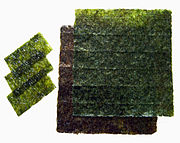
The black seaweed wrappers used in makimono are called nori. Nori is a type of algae, traditionally cultivated in the harbors of Japan. Originally, algae was scraped from dock pilings, rolled out into thin, edible sheets, and dried in the sun, in a process similar to making rice paper. Whereas in Japan, nori may never be toasted before being used in food, many brands found in the U.S. reach drying temperatures above 108 °F (42 °C).
Today, the commercial product is farmed, processed, toasted, packaged, and sold in standard-size sheets about 18 by 21 centimetres (7.1 by 8.3 in). Higher quality nori is thick, smooth, shiny, green, and has no holes. When stored for several months, nori sheets can change color to dark green-brownish.
The standard size of a whole nori sheet mentioned above influences the size of maki-mono. A full size sheet produces futomaki, and a half produces hosomaki and temaki. To produce gunkan and some other makimono, an appropriately sized piece of nori is cut from a whole sheet.
Nori by itself is an edible snack and is available with salt or flavored with teriyaki sauce. The flavored variety, however, tends to be of lesser quality and is not suitable for sushi.
When making fukusazushi, a paper-thin omelette may replace a sheet of nori as the wrapping. The omelette is traditionally made on a rectangular omelette pan (makiyakinabe), and used to form the pouch for the rice and fillings.


For culinary, sanitary, and aesthetic reasons, the minimum quality and freshness of fish to be eaten raw must be superior to that of fish which is to be cooked. The FDA recommends that raw fish be frozen before being consumed, as this will kill all parasites, although not all harmful microorganisms.[26] Professional sushi chefs are trained to recognize important attributes, including smell, color, firmness, and freedom from parasites that may go undetected in commercial inspection. Commonly-used fish are tuna (maguro, shiro-maguro), Japanese amberjack, yellowtail (hamachi), snapper (kurodai), mackerel (saba), and salmon (sake). The most valued sushi ingredient is toro, the fatty cut of the fish. This comes in a variety of ōtoro (often from the bluefin species of tuna) and chūtoro, meaning ‘middle toro’, implying that it is halfway into the fattiness between toro and the regular cut. Aburi style refers to nigiri sushi where the fish is partially grilled (topside) and partially raw. Most nigiri sushi will be completely raw.
Other seafoods such as squid (ika), eel (anago and unagi), pike conger (hamo), octopus (tako), shrimp (ebi and amaebi), clam (mirugai, aoyagi and akagai), fish roe (ikura, masago, kazunoko and tobiko), sea urchin (uni), crab (kani), and various kinds of shellfish (abalone, prawn, scallop) are the most popular seafoods in sushi. Oysters, however, are less common, as the taste is not thought to go well with the rice. Kani kama, or imitation crab stick, is commonly substituted for real crab, most notably in California rolls.

Pickled daikon radish (takuan) in shinko maki, pickled vegetables (tsukemono), fermented soybeans (nattō) in nattō maki, avocado, cucumberinkappa maki, asparagus, yam, pickled ume (umeboshi), gourd (kanpyō), burdock (gobo), and sweet corn (possibly mixed with mayonnaise) are also used in sushi.
Tofu and eggs (in the form of slightly sweet, layered omelette called tamagoyaki and raw quail eggs ride as a gunkan-maki topping) are common.

Sushi is commonly eaten with condiments. Sushi may be dipped in shōyu, soy sauce, and may be flavored with wasabi, a piquant paste made from the grated root of the Wasabia japonica plant. However, some consider the use of condiments with sushi to be an implication that the chef's original preparation was inadequate.[citation needed] Japanese-style mayonnaise is a common condiment in Japan on salmon, pork and other sushi cuts.
True wasabi has anti-microbial properties and may reduce the risk of food poisoning.[27] The traditional grating tool for wasabi is a sharkskin grater or samegawa oroshi. An imitation wasabi (seiyo-wasabi), made from horseradish, mustard powder and green dye is common. It is found at lower-end kaiten zushi restaurants, in bento box sushi and at most restaurants outside Japan. If manufactured in Japan, it may be labelled "Japanese Horseradish".[28]
Gari (sweet, pickled ginger) is eaten with sushi to both cleanse the palate and aid in digestion. In Japan, green tea (ocha) is invariably served together with sushi. Better sushi restaurants often use a distinctive premium tea known as mecha. In sushi vocabulary, green tea is known as agari.

The main ingredients of traditional Japanese sushi, raw fish and rice, are naturally low in fat, high in protein, carbohydrates, vitamins, and minerals. The same may not be said categorically of Western-style sushi, which increasingly features non-traditional ingredients such as mayonnaise, avocado, and cream cheese.
Most seafood is naturally low in fat, with fats found in seafood predominately being unsaturated and thus containing relatively high levels of Omega-3. Since sushi is often served raw, no cooking fat is introduced during its preparation. Some non-traditional ingredients such as cream cheese and mayonnaise that are sometimes found in Western-style sushi dishes can add significant amounts of fat to a traditionally lean dish.
Fish, tofu, seafood, egg, and many other sushi fillings, contain high levels of protein. Imitation meat such as krab stick may be lower in protein and other nutrition than their natural, unprocessed counterparts.
Vitamins and minerals are found in much of the seafood and vegetables used for sushi. The nutritional content is dependent on the ingredients used. For example, shrimp is high in calcium and iodine, whereas salmon is rich in Vitamin D. The gari and nori used to make sushi are rich in both nutrients. Other vegetables wrapped within the sushi also offer various vitamins and minerals.
Carbohydrates are found in the rice and the vegetables. Certain non-traditional ingredients can raise the carbohydrate level quite high, as with the fat level.
Some large fish, such as tuna (especially bluefin), can harbor high levels of mercury. This is due to the tuna's position at the top of the food chain (among sea creatures). Thus, tuna can lead to mercury poisoning when consumed in large quantity.[29] The FDA recommends, for certain groups (women who might get pregnant, pregnant women, nursing mothers and young children), eating a maximum of 12 ounces a week of a variety of fish and shellfish.[30]
Parasite infection by raw fish involves mainly three kinds of parasites: Clonorchis sinensis (a trematode/fluke), Anisakis (a nematode/roundworm) and Diphyllobothrium (a cestode/tapeworm).[citation needed] Infection risk of anisakis is particularly higher in fish which may live in a river such as salmon (shake) in Salmonidae, and mackerel (saba). Such parasite infections can generally be avoided by boiling, burning, preserving in salt or vinegar, or freezing overnight.
For the above reasons, the EU regulations forbids the use of fresh raw fish. It must be frozen at temperatures below −20 °C in all parts of the product for no less than 24 hours.[31]
Some forms of sushi, notably those containing pufferfish fugu and some kinds of shellfish, can cause severe poisoning if not prepared properly. Particularly, fugu has a lethal dose of tetrodotoxin in its internal organs and must be prepared by a licensed fugu chef who has passed the prefectural examination in Japan.[32] The licensing examination process consists of a written test, a fish-identification test, and a practical test, preparing and eating the fish. Only about 35 percent of the applicants pass, and in rare cases, death results.[33] [failed verification] The Emperor of Japan is forbidden to eat fugu, as it is considered too risky.[34]
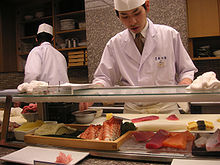
Traditionally, sushi is served on minimalist Japanese-style, geometric, mono- or duo-tone wood or lacquer plates, in keeping with the aesthetic qualities of this cuisine.
Many sushi restaurants offer fixed-price sets, selected by the chef from the catch of the day. These are often graded as shō-chiku-bai (松竹梅), shō/matsu (松, pine), chiku/take (竹, bamboo) and bai/ume), with matsu the most expensive and ume the cheapest.
InJapan, and increasingly abroad,[citation needed] sushi is served kaiten zushi (sushi train) style. Color coded plates of sushi are placed on a conveyor belt; as the belt passes customers choose as they please. After finishing, the bill is tallied by counting how many plates of each color have been taken. Newer kaiten zushi restaurants use barcodesorRFID tags embedded in the dishes to bill automatically and manage elapsed time after the item was prepared.
Some specialized or slang terms are used in the sushi culture. Most of these terms are used only in sushi bars.
Unlike sashimi, which is almost always eaten with chopsticks, nigirizushi is traditionally eaten with the fingers, even in formal settings.[37] While it is commonly served on a small platter with a side dish for dipping, sushi can also be served in a bento, a box with small compartments that hold the various dishes of the meal.
Soy sauce is the usual condiment, and sushi is normally served with a small sauce dish, or a compartment in the bento. Traditional etiquette suggests that the sushi is turned over so that only the topping is dipped; this is because the soy sauce is for flavoring the topping, not the rice, and because the rice would absorb too much soy sauce and would fall apart.[38] If it is difficult to turn the sushi upside-down then one can baste the sushi in soy sauce using gari (sliced ginger) as a brush. Toppings which have their own sauce (such as eel) should not be eaten with soy sauce.
Traditionally, the sushi chef will add an appropriate amount of wasabi to the sushi while preparing it, and etiquette suggests eating the sushi as is, since the chef is supposed to know the proper amount of wasabi to use. However, today wasabi is more a matter of personal taste, and even restaurants in Japan may serve wasabi on the side for customers to use at their discretion, even when there is wasabi already in the roll.[39] If wasabi is added by the diner, it should be applied to the topping using chopsticks, and then the sushi picked up and dipped in soy sauce. The wasabi should not be mixed with the soy sauce, as this dulls the flavor of the wasabi. (This is different from sashimi, where they should be mixed because it is too difficult to apply wasabi to the sashimi.)
In practice, many people—particularly Westerners, both in Japan and abroad—ignore the traditional sushi eating methods. It is common to see diners mixing large amounts of wasabi into their soy dish and dunking the rice straight into it. Further, not all sushi is created the same; traditional nigirizushi is made so that the entire piece can be consumed in one bite, and etiquette considers this the correct way to eat it. However, some chefs may include too much rice or too much topping, making it difficult for some people to fit an entire piece in their mouth, so that two bites or more must be taken. Outside of Japan, it is unusual to eat nigirizushi directly with hands. Typically chopsticks are used for sashimi, nigirizushi, makizushi and hands are only used for temaki.
| Utensil | Definition |
|---|---|
| Fukin | Kitchen cloth |
| Hangiri | Rice barrel |
| Hocho | Kitchen knives |
| Makisu | Bamboo rolling mat |
| Ryoribashi | Cooking chopsticks |
| Shamoji | Wooden rice paddle |
| Makiyakinabe | Rectangular omelette pan |
| Oshizushihako | a mold used to make oshizushi |
{{cite journal}}: Check |doi= value (help)CS1 maint: multiple names: authors list (link)
p.271: Sushi, a roll of cold rice with fish, sea-weed, or some other flavoring
p.181: While we were waiting for my lord and my lady to appear, domestics served us with tea and sushi or rice sandwiches, and the year-old baby was brought in and exhibited.
p.180: All the sushi that I had been unable to eat were sent out to my kuruma, neatly done up in white paper.
Sliced sushi rolls are traditionally made in three different sizes, or diameters: thin 1-inch rolls (hoso-maki); medium 1 1/2-inch rolls (chu-maki); and thick 2 to 2 1/2-inch rolls (futo-maki).""
{{cite journal}}: Unknown parameter |month= ignored (help)
{{cite journal}}: Unknown parameter |month= ignored (help)
Called saba zushi or battera, after the Portuguese term for "small boat", which the mould resembles.
{{cite book}}: |first2= missing |last2= (help); Missing pipe in: |first2= (help)CS1 maint: numeric names: authors list (link)
{{cite journal}}: Unknown parameter |coauthors= ignored (|author= suggested) (help); Unknown parameter |month= ignored (help)
{{cite news}}: Unknown parameter |month= ignored (help)
Template:Link GA Template:Link GA Template:Link FA